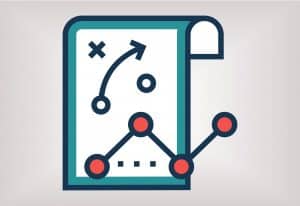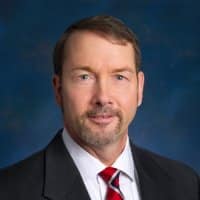[vntd_hero_section images=”60130″ heading_dynamic=”PIN Points – February 2018″ subtitle=”” button1_label=”” bg_overlay=”dark_blue” height=”custom” height_custom=”400″ tooltips=”%5B%7B%22tooltip_title%22%3A%22Hello%20there!%22%2C%22tooltip_url%22%3A%22%23%22%2C%22tooltip_placement%22%3A%22top%22%2C%22tooltip_depth%22%3A%220.42%22%7D%5D”]
Greetings From PIN Chair Greg Knopp
Strategy for Dummies
If you Google “strategy” or “strategic planning” you could spend the next several years reading different perspectives, such as competing theories (Chamberlain vs, Minztberg anyone?), its importance (everything from business to the NFL draft), or its methods (don’t forget your SWOT Analysis, which is always fun to say to an annoying colleague).
It’s obvious that a person or organization should have a strategy in mind when setting up long-term goals, but could strategy be the most confusing, overused and misunderstood concept in the world today?
This issue of the PIN newsletter includes articles on the importance of strategic planning to meet your political program goals, including PAC fundraising and disbursements and important election year activities. Be sure to make them “SMART” – Specific, Measurable, Achievable, Realistic and Time-based.
Michael Porter, a distinguished professor at the Harvard Business School, known for his theories on economics, business strategy and social causes, likes to say that strategy is about making choices and trade-offs; it’s about deliberately choosing your route and rules, and is as much about what you will not do, as what you will. Mark Zuckerberg, co-founder and CEO of Facebook, advises that almost any strategy is better than none. He warns that “the biggest risk is not taking any risk. In a world that changes quickly, the only strategy that is guaranteed to fail is not taking risks.”
In its purest form, strategy is about looking at ways to solve a problem or looking at a problem differently. However, Naveen Jain, a successful tech entrepreneur, believes success doesn’t necessarily come from breakthrough innovation but from flawless execution. He believes a great strategy alone won’t win the day, rather, success comes from mastering the basics of the plan, in his words, “the blocking and tackling.”
Let’s not make this more complex than it is. If you want to succeed, having goals and a plan is a good place to start. Germany Kent , journalist, model, producer, social media diva, activist and the author of the best-seller The Hope Handbook, has a basic, seven-point plan for helping you on your journey for strategic success:
- Start
- Don’t make excuses
- Celebrate small steps
- Ignore critics
- Be consistent
- Be open
- Stay Positive
Seems simple enough.
Some final advice from William Hague, a leader in the British House of Commons: “There’s only one growth strategy: work hard.”
Good luck![/vc_toggle][vc_separator]
Did You Hear the News? Webinars Are Now No-charge for Council Members
The majority of our webinars are now free to members. That’s more than 20 webinar programs on subjects ranging from PAC governance to managing your grassroots database.
Our compliance webinars, which are taught by experienced attorneys, will still cost the regular member price of $169.
Congratulations to Our Certificate in PAC and Grassroots Management Graduates!
During the Advocacy Conference in Orlando, four recipients were presented with the Council’s Certificate in PAC and Grassroots Management.
Top row, from left:
Jennifer Fox, National Restaurant Association, Elizabeth Bartz, State and Federal Communications, Inc.
Bottom row, from left:
Vanessa Kermick, Air Line Pilots Association, International, Casey Mensinger, Public Affairs Council
Compliance Update

This affects for-profit companies and trade associations that are registered under the Lobbying Disclosure Act of 1995 and report lobbying expenses on their quarterly LD-2 reports using the IRC method.
As a result, these affected organizations must now include any local direct legislative lobbying expenses. *Note that the TCJA does not affect grassroots lobbying, which continues to be nondeductible and is reportable on the LD-2 under Method C at all levels (federal, state and local).
The law change is in effect for the LD-2 due on April 20, 2018. If your organization has traditionally used Method C for reporting lobbying expenses on the LD-2 but engages in significant local direct legislative lobbying, you may wish to reassess whether to use the LDA method instead. Please note that a registrant selecting either method must use it for the entire calendar year.
Want more information on filing? Join us for our webinar on March 22: Lobbying Compliance: Filing LD-2 and LD-203.[/vc_toggle][vc_separator]
Over 400 of Your PAC Peers Can't Be Wrong
Looking for the best ideas to tackle your toughest PAC issues? Look no further than the National PAC Conference.
We’re shaping up to have our largest attendance yet and hope you’ll be there to join us.
March 4-7
Loews Miami Beach Hotel
Miami Beach Fla.
Creating a Winning Election-Year PAC Plan

- Monitor Your Progress – Whether you budget for an election cycle or annually, it’s a good time to evaluate where you are and what you still need to accomplish. Are your 2018 fundraising goals hitting the mark? Are you entering 2018 having achieved your 2017 financial targets? Take a look at your priorities, including your committees of jurisdiction, chamber and committee leadership and candidates running in districts where your organization has a large footprint. Have you been able to support everyone you need to thus far and will you be able to support your priority candidates based on the funds you have raised or plan to raise? If not, it’s a good time to make some adjustments to your budget so you’re still able to support your major priorities. If you’re exceeding expectations, start thinking about additional opportunities to make the most of your support strategy. Having a strong understanding of your progress should serve as your guide for the months ahead.
- Create an Election Year Calendar – Now is a great time to take a look at the calendar and outline key dates to keep your PAC program on track, both for your candidate support strategy as well as fundraising and reporting activities. Be aware of the primary dates for candidates you plan to support. Take note of organizational events such as executive leadership meetings, events at various facilities or state chapter meetings that provide an opportunity to give a PAC presentation or organize a small group meeting for peer-to-peer outreach. There are likely plenty of scheduled opportunities that could merit PAC participation.
- Assemble Your Team – Schedule a check-in meeting with your government affairs team or other relevant stakeholders. Even if you already meet regularly, revisiting goals and priorities can increase the PAC’s effectiveness and determine meaningful metrics for success. What does a successful election year look like to your lobbyists? What does it look like to the head of your public affairs team? You may discover shifting priorities or legislative issues that could impact your current plans or enhance the messaging around your PAC efforts. It’s always a good idea to reaffirm internal buy-in, ensure your team members are on the same page and demonstrate that everyone has a stake in the success of the PAC.
- Promote Good Government – PACs have a unique opportunity in an election year to boost good government practices and facilitate engagement in the political process. It’s always beneficial to build in educational opportunities for PAC-eligibles. Consider providing Get Out The Vote (GOTV) communications leading up to primary and general elections in states where your organization has members or employees. These can include voter registration reminders, information on where to vote or reminders about the organization’s policy for taking time to vote on Election Day. Consider other fun activities to raise awareness such as holding a mock election or election prediction contest on your website or newsletter to drive traffic and generate engagement.
- Follow Up and Be Transparent – An election year is a great time to consider reporting out on a more frequent basis. It helps create a sense of urgency and establishes that now is the time to give, while highlighting the important role of the PAC. Plan to send out a post-election report shortly after the election to let your donors know how the PAC did. What was your winning percentage? Who did you support in the election? What was your partisan breakdown for the cycle? Immediate reporting to your PAC donors not only lets them know their money was well spent, but increases their sense of accountability to and transparency in the PAC.
For additional ideas or sample resources, contact Kristin Brackemyre at [email protected].[/vc_toggle][vc_separator]
Member Column: PAC Spending Framework

In 2017, the Air Line Pilots Association (ALPA) PAC spent more than $2 million advocating for pilot partisan policies at the federal level – half a million dollars more than we spent over the entire 2011-12 congressional cycle. We have grown into a large PAC in a short amount of time and that can create the best problems. How should we spend our new money? What’s the most effective strategy for our new size? Why do all these fundraisers keep calling me? We learned that before we could answer most of these questions (the fundraiser one is pretty obvious) we needed to understand how to think about where our money was going. We needed a framework.
- Sustain our relationships with champions in Congress
- Broaden our reach into new areas/offices
- Deepen our influence within political institutions
When you invest in all three attributes in complimentary ways, the benefits of every dollar spent in one category echo off the other two, significantly increasing the value and effect of our members’ PAC money.
The result of this strategy is that our reputation often precedes us. The party committees tell candidates to reach out to us early and they question long-time incumbents who don’t earn our support. Our champions already in Congress tell their colleagues that we have staying power – once we’re in, we stay. Members we might one day support seem to already know our issues from these conversations, cutting down the time we spend on initial education and awareness.
These effects can be accomplished through other means (e.g., soft money at political institutions; active lobby teams reaching out to new members and candidates; organizing local resources for champions, etc.). PACs and contributions are tactical tools, despite the intense focus our community tends to put on them. ALPA has found that this framework, however, allows us to connect all of our political tools and build winning campaigns in Congress. As we look at even more growth, we will continue to use these dimensions to think about our PAC money and how to be the most effective advocates for our members.[/vc_toggle][vc_separator]
Emerging Leader Spotlight: Get to Know Ellen Locke
I always knew I wanted to work in government/politics, but thought it would be more in the international space. However, I ended up applying for and being offered an internship with Congressman David Price (D-NC) and I loved it! That summer completely shifted my attention toward domestic politics and was followed by another internship with Senator Burr (R-NC) the next summer. I moved on to campaigns, working on the Democratic coordinated campaign for Wake County School Board in 2011. Upon graduating, I worked as a field organizer for President Obama’s 2012 reelection campaign in North Raleigh.
From there, I knew I wanted to make the move up to Washington and was able to start with Nationwide as a legislative assistant in February 2013. When our PAC manager took a new opportunity outside the company, I knew that was the role I wanted to have! It combined everything I loved about campaigns/elections, government relations, and politics overall. I’ve now been in the role over a year and I’m preparing to launch my second PAC campaign.
What is your favorite part of working in political involvement?
There’s always something new going on. I never quite know what I’m going to have come across my email from day to day. My favorite part of being a PAC manager, though, is interacting with our amazing members. Given our national profile, I love hearing people around the country give different takes on what’s happening in the news.
What do you think your greatest success has been to date?
Last year’s campaign was our best year yet! We had over 200 new members and almost $200,000 in new cycle income pledged. To work as a team and build on the great foundation left by those that came before in my first year was fantastic.
What advice do you have for newcomers to the public affairs field or to other young professionals?
Always be looking out for new opportunities to grow your role, position or network, even if you don’t think it will lead to something. You never know what will happen and the experience you gain may be the key to moving you up the ladder in the future. I got into the PAC world by reaching out to our PAC manager to see if I could help recruit new members in the D.C. area during August recess. Become a yes (wo)man and actively seek out new knowledge sets/projects!
What is your favorite DC eatery?
We the Pizza is my absolute favorite. My first time having it was during a massive heat wave during my internship. It was about 110 outside, their air conditioning had broken, and I was sitting in a boiling hot restaurant and it was still amazing. That’s how I knew I had struck gold.[/vc_toggle][vc_separator]
Help Us Help You: Participate in Our Annual Surveys
This survey is for all professionals whose grassroots or advocacy-related responsibilities account for at least 50 percent of their job time.
Fly-In Best Practices
This survey should be completed by organizations that currently hold at least one lobby day event.
PAC Professional Profile: Salary and Responsibilities Survey
This survey is for PAC professionals who spend at least 50 percent of their time on PAC-related activities.
PAC Match Survey
This survey should be completed only by those who currently operate a PAC charitable match program.



